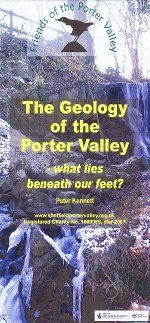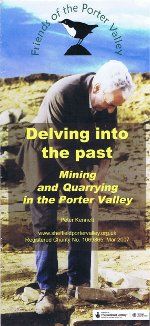Porter Valley Walks
The River Porter flows from open moorland on the west side of Sheffield to its confluence with the Rivers Sheaf and Don near the city centre. The influence of the geology on the landscape is self-evident throughout its catchment, and public ownership of land in its rural parts means that there is free access to much of the valley floor.
Three leaflets have been produced for the Friends of the Porter Valley www.fopv.org.uk
, which are
available below in pdf format for downloading.
The Geology of the Porter Valley - what lies beneath our feet?
(Published as an A3 fold-out leaflet by the Friends of the Porter Valley in 2007)
The locations of 11 sites are shown on a specially redrawn geological map and identified by grid reference, photographs and sketches. Geological features range from gritstone tors on Burbage Moor at Ringinglow to former sandstone quarries on Brincliffe Edge. With perseverance, evidence of former marine conditions may be found in the shales of the river banks. The age of the rocks ranges from the Chatsworth Grit (of "Millstone Grit" age) to the Greenmoor Rock of Lower Coal Measures age. Because of the general easterly dip of the strata, the oldest beds occur at the head of the valley and the youngest lower down its course.
Ordnance Survey ©Crown copyright (2006) all rights reserved. Licence number 100049642. CP12/057 British Geological Survey ©NERC. All rights reserved

Delving into the past - mining and quarrying in the Porter Valley
(Published as an A3 fold-out leaflet by the Friends of the Porter Valley in 2007)
For several centuries, the rocks of the valley were exploited for their uses as building stones and
roofing flags; for grindstones and gravestones; for brick-making and for refractory materials for use in Sheffield's steel industry. There were also many small scale coal pits, ranging from bell pits to shaft mines and drift mines, the last of which closed as recently as 1929.
No particular itinerary is suggested, but the location map enables visits to former sites to be planned, possibly as an adjunct to following the geology itself. The leaflet is illustrated with photographs, some of them from archives, and extracts of old maps.
Ordnance Survey ©Crown copyright (2006) all rights reserved. Licence number 100049642. CP12/057 British Geological Survey ©NERC. All rights reserved

Reading the Landscape in the Porter Valley
(Published as an A3 fold-out leaflet by the Friends of the Porter Valley in 2004)
The purpose of this leaflet is to provide an introduction to the development of the historical landscape of this rural part of the Porter Valley. The geology is secondary, and yet is of considerable importance in framing the physical landscape and in providing materials for the building of houses and farms, walls, gateposts and dams. The construction of drystone walls and the shapes of the fields enable the contrast to be drawn between probable Romano-British settlement and widespread enclosure following the Enclosure Acts in the 18th and 19th Centuries.
An itinerary of about 1½ miles is suggested, with numbered locations, starting from Forge Dam (with its Café!)

N.B.
The inclusion of a site does not imply that there is any right of access. Some site features may be viewed from public roads and paths, but many sites are in private ownership and permissions from the landowner and/or land manager may be needed to visit more closely. Health and Safety risk assessments should be made prior to visiting all sites, to include such hazards as traffic, trip hazards or rock falls. SAGT takes no responsibility for any injury sustained, nor for any infringement of ownership rights, as a result of a site being described on this website.
